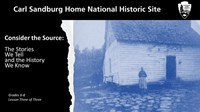- Lesson Plan (81)
- Distance Learning (53)
- Field Trips (35)
- Student Activities (18)
- Guest Speakers (9)
- Traveling Trunk (6)
- Teacher Reference Materials (3)
- Field Schools & Institutes (2)
- Other Education Materials (2)
- Primary Sources (2)
- Acadia National Park (19)
- Gateway Arch National Park (12)
- Fort Scott National Historic Site (9)
- Homestead National Historical Park (7)
- Charles Young Buffalo Soldiers National Monument (6)
- Grant-Kohrs Ranch National Historic Site (6)
- Olympic National Park (6)
- Eisenhower National Historic Site (4)
- Glacier National Park (4)
- Show More ...
- Social Studies (143)
- Science (76)
- Literacy and Language Arts (48)
- Math (9)
Showing 200 results for west side ...
West Side Scavenger Hunt
"We Proceeded On..."
- Type: Lesson Plan
- Grade Levels: Upper Elementary: Third Grade through Fifth Grade
Students will learn about maps and what information can be gathered from them through the use of maps of the lower Columbia River. Using math and timing their own walking speeds students will be able to determine how long it would take to drive from one location to Fort Clatsop, walk to Fort Clatsop, and how much that would cost.
We Want You!
- Type: Student Activities
- Grade Levels: High School: Ninth Grade through Twelfth Grade
At the start of the U.S.-Mexican War, both Mexican and U.S. citizens mistrusted a standing army. In this activity, students discuss reasons for joining an army. Next, they discuss the differences between a regular army and a militia of volunteers. Then they review and discuss U.S. and Mexican perspectives on regular and volunteer soldiers.
We The People: Life at a Frontier Fort
Heading West?
We the People: Challenges of Life at a Frontier Fort
What Happens to the Water When We Brush and Flush?
- Type: Lesson Plan
- Grade Levels: Middle School: Sixth Grade through Eighth Grade
Water from homes and businesses enters sewers or septic tanks through pipes. This wastewater is kept with other dirty water because it is unhealthy and must be kept away from our drinking water. This sewer water is sent to a water treatment plant where the unhealthy parts are removed. The water is then returned to the river sometimes cleaner than it was originally. This lesson raises real world concerns, guiding students to become better stewards of our environment.
Choosing Sides: Loyalist v. Patriot
- Type: Lesson Plan
- Grade Levels: Upper Elementary: Third Grade through Fifth Grade
This lesson plans highlights why North Carolina colonists chose to side with either the Loyalists or the Patriots
West Beach Walk
- Type: Field Trips
- Grade Levels: Lower Elementary: Pre-Kindergarten through Second Grade
We Have a Story to Tell: Native Peoples of the Chesapeake Region
- Type: Teacher Reference Materials
- Grade Levels: High School: Ninth Grade through Twelfth Grade
This lesson primarily covers the period from the early 1600s to the present. Students explore how colonial settlement and the establishment of the United States affected the Native Americans of the Chesapeake region, especially the Powhatan, Nanticoke, and Piscataway peoples. Students will learn about the forces that resulted in the eradication of some tribes and how others survived.
Consider the Source: The Stories We Tell and The History We Know (Grade 6 -8) Lesson 3 of 3 Carl Sandburg Home NHS
- Type: Lesson Plan
- Grade Levels: Middle School: Sixth Grade through Eighth Grade
This is the 3rd of 3 lessons designed to contribute to middle school student's working knowledge of Black history in Western North Carolina (W.N.C.) and to give them the skills to identify common myths of the region as well. This lesson introduces critical thinking concepts such as anachronisms and explores myths and deferred histories from W.N.C. This lesson is intended to exercise historical thinking skills and encourage the dialogue studied in previous lessons.
Star Fort: Whose side are you on anyway?
- Type: Lesson Plan
- Grade Levels: Upper Elementary: Third Grade through Fifth Grade
Objectives At the end of this activity, the student will be able to list the reasons for fighting for both the British and the Americans.
- Type: Lesson Plan
- Grade Levels: Middle School: Sixth Grade through Eighth Grade
This lesson plan includes mapmaking, class discussions, image and writing analysis. Students have the opportunity to learn about the Mormon Pioneer and Oregon Trail through the NebraskaStudies.org site. Here, they will be able to access primary and secondary source documents, as well as a timeline of events on the trail.
Heading West? (Distance Learning)
- Type: Distance Learning
- Grade Levels: Lower Elementary: Pre-Kindergarten through Second Grade
Lessons Learned In West Branch
- Type: Field Trips ... Student Activities
- Grade Levels: Upper Elementary: Third Grade through Fifth Grade
What can we learn about the lives of enslaved people from primary sources?
- Type: Primary Sources ... Student Activities ... Teacher Reference Materials
- Grade Levels: Upper Elementary: Third Grade through Fifth Grade
African Americans of the West Traveling Trunk
Civil War in the West Traveling Trunk
- Type: Traveling Trunk
- Grade Levels: Upper Elementary: Third Grade through Fifth Grade
What was it like to live in the Midwest during the Civil War? This traveling trunk will explore the Civil War through the eyes of two children who grew up in St. Louis during the nineteenth century. Although they did not live on the edge of any major battles, they felt the conflict and tension that the war years brought with it.
The Other Side of Fort Pulaski: Walking Tour Outside the Fort
- Type: Field Trips
- Grade Levels: Upper Elementary: Third Grade through Fifth Grade
This is a teacher-led activity to be done on site at the fort. The teacher will lead a walk around the outside of the fort to show students dramatic battle damage from the Civil War battle, including projectiles that are still lodged in the brick walls. It also highlights the salt marsh ecology on Cockspur Island, and shows how human influence has repeatedly changed the island’s environment over time.

















